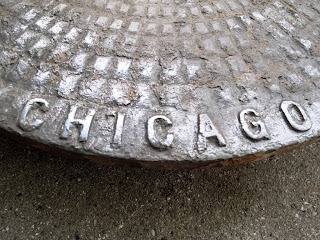Remember my manhole covers? Turns out they are off of the shipwreck William Dickenson, a tug boat that was built in 1893 in Benton Harbor, Michigan by E. W. Heath for the Independant Towing Company for use in Chicago. In 1895, the tug boat helped in the search for the victoms of the Chicora. In a newspaper dated 1904 from "The Eau Claire Leader" of Eau Claire, Wisconsin had an article saying: "A large touring automobile, with four shreiking occupants - three men and a woman - shot through the open draw of the Rush street bridge at 11 pm and plunged into the Chicago River, turning a sumersault as it fell." The crew of the William Dickenson along with Sailor Lewis Mohr rescued the four passengers. This story made National News. We found newspaper articles covering this story from "The Waterloo Times - Tribune" of Waterloo, Iowa, "The Bismark Daily Tribune" of Bismark, North Dakota, and "The Daily Huronite" of South Dakota.
In 1923 the tug boat caught on fire in Marine City, Michigan. The "Port Huron Times" reports: 'According to the crew, the fire is believed to have originated in the coal bunkers, late Saturday night. Fought by the crew the fire was soon under control but broke out again more severely in places difficult to reach. The vessel was cut loose from its moorings and allowed to drift out into chanel where it partially sank. When the fire became so dangerous that it might spread to other vessels docked at the shipyard it was necessary to cut the burning tug from its moorings and allow it to drift away from its doc and nearby vessels.'
Today there isn't much left of the William Dickenson and there is even less now that 2 of her manhole covers have taken residence in my garage. Ray cleaned them up a bit and upon closer examination they are pretty cool. Some of the raised letters are backwards: the "D"s in Foundry and Indiana, and the "3"s . The covers were manufactured in Chicago by the R M Eddy Foundry! It has a simple pattern that radiats out from the center of the cover. There is even an indentation where the ring used to be to lift the covers up. Based on the amount of corrosion present, we don't think that they are entirely made of steel. My guess is that it is made of gray iron, a common material used in Foundries.
So how does one recover not one but two manhold covers that weigh about 50lbs a piece while being weighted down with dive equipment? Well, you would use C-clamps of course! You get yourself about 3 or 4 C-clamps, suit up, dive under the water where the visiblility is about 10 inches in front of your face, and start feeling for some round things that might or might not be your manhole covers. Then after you have felt around for a good half hour through the mud and underwater grass, you feel something that might be promising. Clamp on the c-clamp in several locations, tie your rope through the clamps, attach a lift bag and let the air lift up the manhole covers and pray to God Almighty that everything goes according to plan, because if it doesn't you are right back at square one with your 50lb manhole cover at the bottom of the St Clair River. Luckily for Ray, everything went according to plan, the second time around!



No comments:
Post a Comment